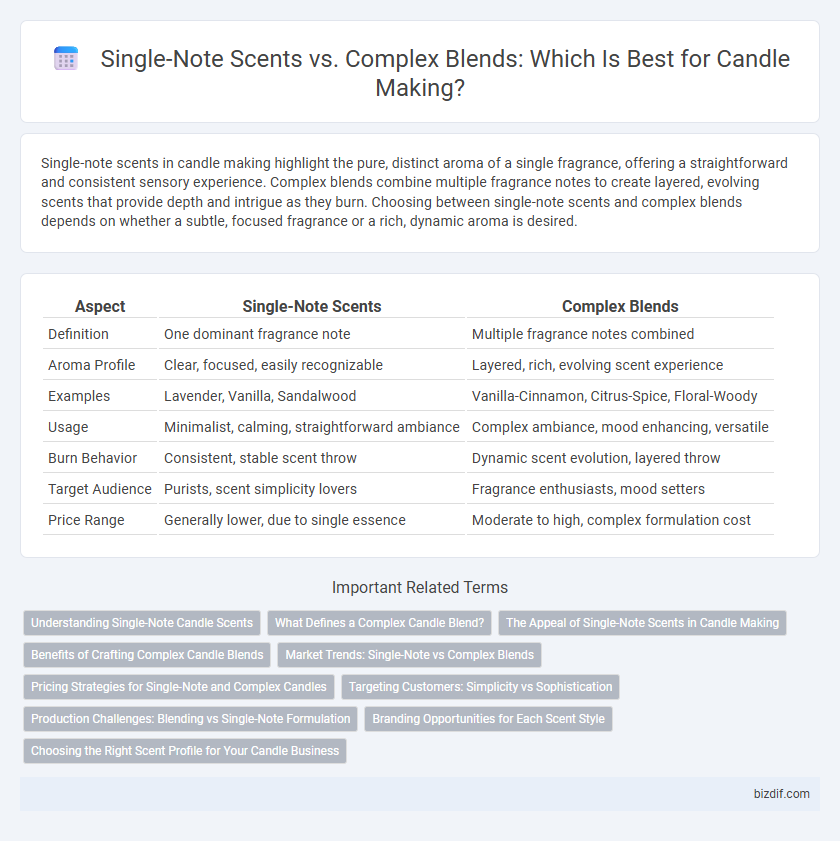Single-note scents in candle making highlight the pure, distinct aroma of a single fragrance, offering a straightforward and consistent sensory experience. Complex blends combine multiple fragrance notes to create layered, evolving scents that provide depth and intrigue as they burn. Choosing between single-note scents and complex blends depends on whether a subtle, focused fragrance or a rich, dynamic aroma is desired.
Table of Comparison
| Aspect | Single-Note Scents | Complex Blends |
|---|---|---|
| Definition | One dominant fragrance note | Multiple fragrance notes combined |
| Aroma Profile | Clear, focused, easily recognizable | Layered, rich, evolving scent experience |
| Examples | Lavender, Vanilla, Sandalwood | Vanilla-Cinnamon, Citrus-Spice, Floral-Woody |
| Usage | Minimalist, calming, straightforward ambiance | Complex ambiance, mood enhancing, versatile |
| Burn Behavior | Consistent, stable scent throw | Dynamic scent evolution, layered throw |
| Target Audience | Purists, scent simplicity lovers | Fragrance enthusiasts, mood setters |
| Price Range | Generally lower, due to single essence | Moderate to high, complex formulation cost |
Understanding Single-Note Candle Scents
Single-note candle scents feature a singular, distinct fragrance derived from one essential oil or aroma, such as lavender or sandalwood, offering a pure and consistent olfactory experience. These scents allow candle makers to highlight the natural qualities of individual ingredients, providing clarity and simplicity in aroma that appeals to minimalist preferences. Single-note candles are effective for creating a specific mood or atmosphere, making them popular for aromatherapy and targeted scent environments.
What Defines a Complex Candle Blend?
A complex candle blend is defined by the harmonious layering of multiple fragrance notes that create a rich, multidimensional aroma experience. Unlike single-note scents that highlight one dominant fragrance, complex blends combine top, middle, and base notes to evoke depth, balance, and evolving scent profiles over time. These intricate mixtures often include complementary essential oils, spices, florals, and woods to deliver a sophisticated and long-lasting fragrance.
The Appeal of Single-Note Scents in Candle Making
Single-note scents in candle making offer a pure, undiluted fragrance that allows the true essence of a specific aroma, like lavender or vanilla, to shine through, creating a clean and focused sensory experience. These scents appeal to minimalists and those sensitive to strong or mixed fragrances, providing a subtle, calming atmosphere in any space. Their simplicity ensures consistency in scent throw, making them a reliable choice for crafters seeking straightforward, elegant candle creations.
Benefits of Crafting Complex Candle Blends
Crafting complex candle blends unlocks a rich sensory experience by combining multiple fragrance notes that evolve over time, enhancing ambiance and mood. These multi-layered scents create depth and intrigue, appealing to a broader range of preferences and elevating the overall candle quality. Candle makers gain creative flexibility and market differentiation by mastering these sophisticated blends, attracting discerning customers seeking unique aromatic profiles.
Market Trends: Single-Note vs Complex Blends
Single-note scents dominate niche candle markets due to their clean, recognizable aromas appealing to minimalists and fragrance purists. Complex blends are gaining traction as consumers seek layered, evolving experiences that evoke emotions and memories, driving innovation in artisanal candle brands. Market analysis shows a 25% annual growth in premium blended candles, reflecting rising demand for personalized and sophisticated home fragrances.
Pricing Strategies for Single-Note and Complex Candles
Single-note scents in candle making typically allow for lower production costs due to the simplicity of using one primary fragrance oil, resulting in more competitive pricing and easier inventory management. Complex blends demand higher investments in premium, varied essential oils and precise formulation, justifying a premium pricing strategy that reflects the enhanced sensory experience and craftsmanship. Pricing for both types should factor in fragrance load, candle size, and target market preferences to optimize profitability while appealing to diverse customer segments.
Targeting Customers: Simplicity vs Sophistication
Single-note scents in candle making appeal to customers seeking simplicity and clarity, offering pure, recognizable aromas like lavender or vanilla that evoke comfort and relaxation. Complex blends target sophisticated buyers who appreciate layered fragrances combining floral, woody, and spice notes for a nuanced sensory experience. Understanding these preferences helps candle makers tailor products to distinct market segments, enhancing customer satisfaction and brand loyalty.
Production Challenges: Blending vs Single-Note Formulation
Single-note scents in candle making offer a straightforward production process with consistent aroma profiles, simplifying quality control and formulation accuracy. Complex blends require meticulous balancing of multiple fragrance oils, increasing the risk of scent incompatibility and variability between batches. Achieving the desired harmony in blends demands rigorous testing and expertise to ensure a stable, appealing fragrance that maintains performance during burning.
Branding Opportunities for Each Scent Style
Single-note scents offer clear, easily recognizable fragrances that strengthen brand identity through consistent, memorable aromas. Complex blends provide opportunities for unique signature scents that differentiate brands and evoke sophisticated sensory experiences. Both scent styles enable candle makers to target distinct market segments, enhancing brand positioning and customer loyalty.
Choosing the Right Scent Profile for Your Candle Business
Single-note scents, such as lavender or vanilla, offer clarity and a strong, recognizable aroma that appeals to customers seeking simplicity and purity. Complex blends combine multiple fragrance oils to create unique, layered experiences that can differentiate your candle business in a competitive market. Selecting the right scent profile depends on your target audience's preferences and brand identity, balancing familiarity with innovation to maximize customer satisfaction and market reach.
Single-note scents vs Complex blends Infographic

 bizdif.com
bizdif.com